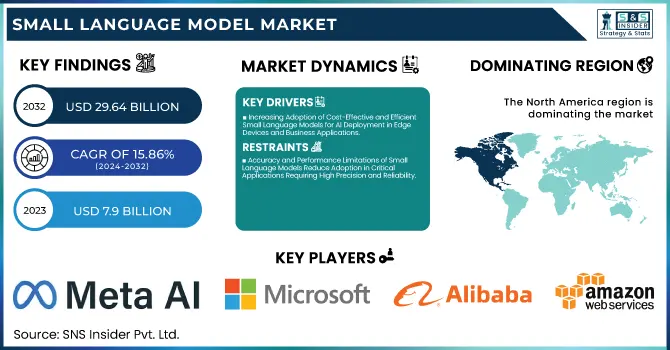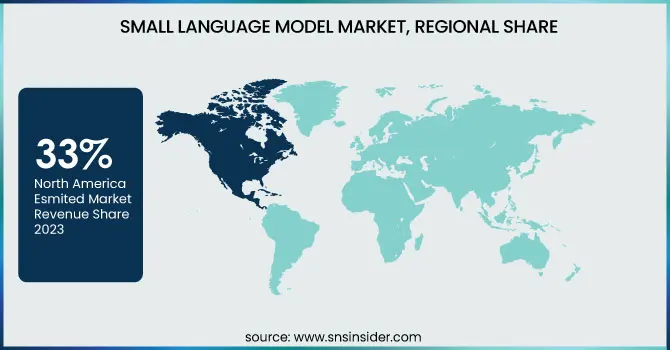Small Language Model Market Report Scope & Overview:
The Small Language Model Market was valued at USD 7.9 billion in 2023 and is expected to reach USD 29.64 billion by 2032, growing at a CAGR of 15.86% from 2024-2032.This report provides a comprehensive analysis of adoption rates, investment, and cost effectiveness, presenting analysis of how companies are embedding small language models to improve productivity and automate operations. It also investigates user bases, determining significant industries driving demand, including healthcare, finance, and customer support. Advances in technology, such as enhanced algorithms and processing, will drive growth, broadening the applications and uses of the market across sectors. As language models advance, both the consumer and enterprise worlds will be affected immensely.

To Get more information on Small Language Model Market - Request Free Sample Report
Small Language Model Market Dynamics
Drivers
-
Increasing Adoption of Cost-Effective and Efficient Small Language Models for AI Deployment in Edge Devices and Business Applications
Growing adoption of AI in resource-scarce environments is driving demand for Small Language Models (SLMs) as they provide better efficiency while consuming less computational resources and memory. In contrast to big models, SLMs allow easy deployment on edge devices with minimal infrastructure expenses but without sacrificing performance. Their cost savings render them extremely desirable for companies that require scalable AI with little need for large hardware expenditures. SLMs also allow real-time processing in use cases such as smart assistants, IoT devices, and enterprise automation, further propelling their market growth. While business organizations emphasize low cost and effectiveness, the adoption of smaller, optimized AI models gains strength with the increasing adoption of SLMs for widespread industry use.
Restraints
-
Accuracy and Performance Limitations of Small Language Models Reduce Adoption in Critical Applications Requiring High Precision and Reliability
Optimization techniques such as quantization and pruning, essential for reducing computational demands, often lead to compromises in accuracy and overall performance. Small Language Models (SLMs) may struggle with maintaining contextual depth, resulting in errors or inconsistencies in outputs. This limitation affects their adoption in critical applications requiring high precision, such as legal, medical, and financial sectors. Businesses relying on AI for advanced decision-making may find SLMs inadequate compared to larger models. Furthermore, performance degradation can hinder real-time processing in edge computing environments, limiting their scalability. As industries demand reliable AI solutions, concerns over accuracy and performance gaps continue to slow widespread acceptance, prompting the need for further model optimization and refinement.
Opportunities
-
Growing Demand for AI-Powered Edge Devices Boosts Adoption of Small Language Models in Smart Assistants, Industrial Automation, and IoT Applications
The increasing reliance on AI-driven edge computing is fueling demand for Small Language Models (SLMs) in various applications, including smart assistants, industrial automation, and IoT devices. As businesses seek real-time, on-device processing with minimal latency, SLMs offer an efficient alternative to cloud-dependent AI models. Their lightweight architecture allows seamless integration into edge devices, enabling faster decision-making in sectors like manufacturing, healthcare, and smart homes. Additionally, industries prioritizing data privacy benefit from SLMs that operate locally without extensive cloud connectivity. With continuous advancements in AI optimization, SLMs are well-positioned to drive the next wave of intelligent automation across diverse applications, making them a preferred choice for cost-effective and scalable AI solutions.
Challenges
-
Data Privacy, Bias, and Ethical Concerns Limit Adoption of Small Language Models Amid Growing Demand for Secure and Fair AI Solutions
As AI adoption grows, Small Language Models (SLMs) face increasing scrutiny over data privacy, bias, and ethical considerations. Many organizations prioritize secure AI solutions that protect sensitive information, yet SLMs operating on local devices still require robust security measures to prevent data leaks or unauthorized access. Additionally, mitigating biases in language models remains complex, as training data often reflects inherent societal prejudices. Failure to address these concerns can lead to regulatory challenges and reduced trust in AI-driven applications. With stricter compliance standards emerging worldwide, developers must focus on improving transparency, fairness, and security within SLMs to ensure responsible deployment while maintaining user confidence in AI-powered solutions.
Small Language Model Market Segment Analysis
By Application
Consumer Applications dominated the Small Language Model Market in 2023, holding the largest revenue share of around 29%. The leadership is fueled by the extensive adoption of Small Language Models (SLMs) within virtual assistants, chatbots, and recommendation systems. These models are improving the user experience across mobile apps, smart home appliances, and automated customer services. The increasing need for AI-powered consumer interactions, in combination with improvements in on-device computing, has cemented the category's dominance through making SLMs more affordable, effective, and economical for end customers.
The healthcare segment is expected to expand at the fastest CAGR of 18.31% during 2024-2032, driven by rising utilization of SLMs for medical diagnosis, patient interaction, and admin automation. AI-based solutions are enhancing clinical decision-making, automating documentation, and supporting real-time virtual health assistants. The need for secure, privacy-compliant AI in hospitals and telemedicine is fueling adoption. Moreover, innovations in domain-specific AI training for healthcare use cases are making SLMs more precise and reliable, driving quick market growth.
By Technology
Machine Learning-based segment accounted for the largest share of around 58% in the Small Language Model Market in 2023. This prevalence is due to its extensive usage across industries for use cases like predictive analytics, natural language processing, and automation. Machine Learning models are less computationally demanding than Deep Learning and thus cost less and are more accessible to companies. Moreover, businesses opt for ML-based SLMs due to their explainability, quicker processing rate, and capacity to run effectively on edge devices without requiring heavy infrastructure.
Deep Learning-based segment is expected to grow at the fastest CAGR of 17.84% during 2024-2032 as it possesses a higher capability to process intricate language functions with more accuracy. Deep Learning facilitates sophisticated contextual awareness, and hence it is required for use cases like conversational AI, real-time translations, and domain-specific text generation. With ongoing innovations in neural network architectures and growing availability of high-performance hardware, enterprises are investing in Deep Learning-based SLMs to improve automation, personalization, and AI-driven decision-making in industries.
By Deployment
Cloud segment led the Small Language Model Market in 2023 with the largest revenue share of approximately 58%. This is due to the cost savings, flexibility, and scalability of cloud-based deployments. Organizations favor cloud-based Small Language Models (SLMs) due to their capacity for processing large datasets, remote access, and live updates. The cloud infrastructure also facilitates easy incorporation of AI-driven applications, diminishing the necessity of on-premises hardware. The increasing adoption of AI-as-a-Service (AIaaS) also lends greater strength to the cloud segment in the industry.
Hybrid segment is expected to grow at the fastest CAGR of 18.25% during the period from 2024 to 2032 with growing demand for a balanced hybrid approach between on-device processing and cloud efficiency. Hybrid deployment modes provide better data privacy, minimized latency, and cost savings by enabling selective on-device processing along with cloud-based resources on-demand. This method is especially useful for highly regulated industries like healthcare and finance. With organizations looking for both performance and security, hybrid SLM implementation is growing fast in different industries.
Regional Analysis
North America dominated the Small Language Model Market in 2023, capturing the highest revenue share of about 33%. This dominance is driven by strong technological infrastructure, high adoption of AI across industries, and significant investments from leading tech companies. The region benefits from the presence of major AI research hubs, fostering continuous innovation in Small Language Models (SLMs). Additionally, widespread enterprise adoption in sectors such as finance, healthcare, and customer service, along with supportive regulatory frameworks, has strengthened North America’s leadership in the market.
Asia Pacific is expected to grow at the fastest CAGR of 17.78% from 2024 to 2032 due to rapid digital transformation, increasing AI adoption, and government initiatives promoting artificial intelligence. The region’s expanding tech ecosystem, driven by countries like China, Japan, and India, is fueling demand for SLMs in industries such as e-commerce, manufacturing, and telecommunications. Additionally, the growing number of AI startups and investments in cloud infrastructure are accelerating market growth. Rising internet penetration and smartphone usage further contribute to the rapid expansion of SLM applications in Asia Pacific.

Get Customized Report as per Your Business Requirement - Enquiry Now
Key Players
-
Meta AI (LLaMA, BlenderBot)
-
Microsoft (Azure Cognitive Services, Turing NLG)
-
Salesforce AI (Einstein Language, Salesforce NLP)
-
Alibaba (AliMe, PAI NLP)
-
Mosaic ML (MosaicML Platform, MosaicML Optimizer)
-
Technology Innovation Institute (TII) (Falcon, GPT-3)
-
Hugging Face (Transformers, Datasets)
-
OpenAI (GPT-4, Codex)
-
Google DeepMind (BERT, Gemini)
-
Amazon Web Services (AWS) (Amazon Comprehend, Amazon SageMaker)
-
IBM Watson (Watson NLP, Watson Assistant)
-
Baidu (Ernie, Baidu Apollo)
-
Anthropic (Claude, Anthropic AI Safety)
-
Cohere (Cohere Command, Cohere Language Models)
-
xAI (founded by Elon Musk) (XAI GPT, XAI Chatbot)
-
Grammarly (Grammarly Writing Assistant, Grammarly Business)
-
Jasper AI (Jasper Chat, Jasper Art)
-
Replit (Replit AI, Ghostwriter)
-
Neudesic (Neudesic AI, Neudesic LLMs)
-
EleutherAI (GPT-Neo, GPT-J)
Recent Developments:
-
In 2024, Microsoft introduced Phi-3, a family of small language models (SLMs) that outperformed similarly sized models across various benchmarks, including language, reasoning, and coding tasks, showcasing their potential in AI applications.
-
In 2024, Salesforce AI introduced the xLAM family of small language models, demonstrating that smaller, task-specific models can outperform larger ones while maintaining efficiency and reducing costs, marking a significant shift towards more compact AI solutions for diverse applications.
| Report Attributes | Details |
|---|---|
| Market Size in 2023 | USD 7.9 Billion |
| Market Size by 2032 | USD 29.64 Billion |
| CAGR | CAGR of 15.86% From 2024 to 2032 |
| Base Year | 2023 |
| Forecast Period | 2024-2032 |
| Historical Data | 2020-2022 |
| Report Scope & Coverage | Market Size, Segments Analysis, Competitive Landscape, Regional Analysis, DROC & SWOT Analysis, Forecast Outlook |
| Key Segments | • By Technology (Deep Learning Based, Machine Learning Based, Rule Based System) • By Deployment (Cloud, On-premises, Hybrid) • By Application (Consumer Applications, Enterprise Applications, Healthcare, Finance, Retail, Legal, Others) |
| Regional Analysis/Coverage | North America (US, Canada, Mexico), Europe (Eastern Europe [Poland, Romania, Hungary, Turkey, Rest of Eastern Europe] Western Europe] Germany, France, UK, Italy, Spain, Netherlands, Switzerland, Austria, Rest of Western Europe]), Asia Pacific (China, India, Japan, South Korea, Vietnam, Singapore, Australia, Rest of Asia Pacific), Middle East & Africa (Middle East [UAE, Egypt, Saudi Arabia, Qatar, Rest of Middle East], Africa [Nigeria, South Africa, Rest of Africa], Latin America (Brazil, Argentina, Colombia, Rest of Latin America) |
| Company Profiles | Meta AI, Microsoft, Salesforce AI, Alibaba, Mosaic ML, Technology Innovation Institute (TII), Hugging Face, OpenAI, Google DeepMind, Amazon Web Services (AWS), IBM Watson, Baidu, Anthropic, Cohere, xAI, Grammarly, iFLYTEK, Jasper AI, Replit, Neudesic, EleutherAI |

